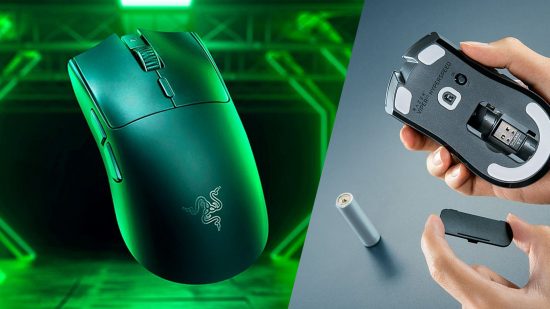When it comes to PC gaming peripherals, Razer is one of the most iconic brands in the business, consistently producing products that find their way on our best gaming mouse, best gaming keyboard, and best gaming headset guides. Its latest contender for our attention is the newly-announced Razer Viper V3 HyperSpeed, which is a new wireless esports gaming mouse that ditches cables completely, opting instead for AA battery power.
The Viper line is known for its lightweight, fingertip grip and claw grip-focused shape, and the Viper V3 HyperSpeed is no different. However, while similar to previous versions at a glance, this new version is different in many ways.
For a start, this version is a right-handed design, rather than the ambidextrous design of the likes of the Viper 8KHz and Viper Ultimate. Razer had already iterated to a right-hand-only design with the Viper V2 Pro, but the 8K and Ultimate remain on sale so we might have hoped other new models would keep the ambidextrous option.
Elsewhere, the new mouse includes several more subtle design tweaks. The sides of the main buttons now have fixed edges for resting your fingers on, rather than the buttons stretching all the way to the edges of the mouse. The main two buttons also have deeper finger grooves, the main hump of the mouse is a little taller and further back, and the gap between the side buttons has increased. The older Viper design was always quite small and arguably a little cramped so these changes will probably appeal to a wider array of gamers.
Comfort isn’t the only thing going for the Razer Viper V3 HyperSpeed, as there’s also the inclusion of an updated Focus Pro 30K optical sensor. Surprisingly, this new sensor includes improved surface compatibility with the ability to track on glass, which is not something we’ve seen before on an optical gaming mouse – the likes of Logitech’s Darkfield technology on productivity mice can do it but normal optical sensors can’t.
The sensor also includes Asymmetric Cut-off that lets the user ‘individually set a lift-off and landing distance that’s tuned to your playstyle—with 26 granular levels of height adjustment compared to only 3 in the previous version.’ All that and the sensor boasts ludicrous tracking numbers of 750 inches per second, 70G acceleration, and 30K DPI. You can also get up to 4KHz polling rate via the separately-sold Razer HyperPolling Wireless Dongle.
The big caveat with this mouse, though, is its battery and power system in general. It cannot be plugged into your system via a cable at all and doesn’t use a rechargeable battery. Instead, it runs off AA batteries, much like the Corsair Katar Wireless, for instance.
This has the advantage of up to 280 hours of battery life, but means that when it runs out you can’t just plug in and carry on playing – you’ll need a spare battery to hand. What’s more, AA batteries are heavy so this mouse is correspondingly heavier than other top-tier wireless esports mice. It weighs 89g, which is still reasonably light, but competitors regularly come in at under 70g.
As is often the case with AA-powered mice, though, another advantage of this model is its relatively low price. It’s priced at just $69.99 at release. That’s $90 cheaper than the Razer Viper V2 Pro HyperSpeed wireless gaming mouse, making it a more budget-friendly alternative.
If you need more Razer products in your life, check out our Razer BlackShark V2 HyperSpeed gaming headset review or our Razer Blade 16 review.
